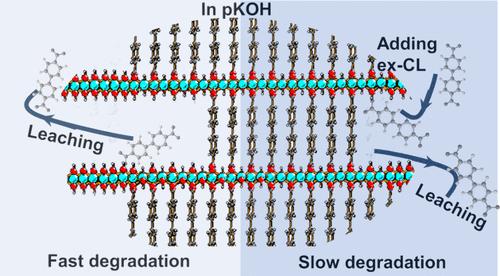在氧进化反应中调整金属有机框架的重构
IF 11.3
1区 化学
Q1 CHEMISTRY, PHYSICAL
引用次数: 0
摘要
最近,人们对将金属有机框架(MOF)转化为用于碱性氧进化反应(OER)的金属氢氧化物催化剂越来越感兴趣。研究表明,MOF 衍生中间体的初始 OER 性能超过了传统的金属氢氧化物催化剂,但关于这些催化剂的耐久性和电化学稳定性的争论仍在继续。此外,MOF 衍生催化剂不可避免地会从无序相重组(老化)为有序相,特别是那些主要由羟基镍组成的催化剂,这仍然是一个讨论的话题。为了解决这些问题,我们提出了一种简单直接的方法,通过在电解质中引入额外的有机羧酸盐连接体,来缓解 MOF 在苛刻碱性环境中的重构和老化。具体来说,我们将重点讨论两个例子:Ni-BPDC-MOFs和NiFe-BPDC-MOFs,其化学式为[M2(OH)2BPDC](M:Ni和Fe;BPDC=4,4′-联苯二甲酸酯)。实验结果表明,含有额外 BPDC 连接体的碱性电解质具有更强的 OER 活性和更长的电化学寿命。通过原位拉曼光谱分析,我们的研究结果表明,操纵参与 Ni-MOF 形成(连接体组装)和重构(连接体浸出)的有机连接体的配位平衡,可形成更无序的氧氢氧化镍相作为活性催化剂材料,从而提高 OER 性能。本文章由计算机程序翻译,如有差异,请以英文原文为准。

Tuning the Reconstruction of Metal–Organic Frameworks during the Oxygen Evolution Reaction
Recently, there has been growing interest in the conversion of metal–organic frameworks (MOFs) into metal-hydroxide catalysts for alkaline oxygen evolution reactions (OERs). While studies have shown that the initial OER performance of MOF-derived intermediates surpasses that of traditional metal-hydroxide catalysts, ongoing debates persist regarding these catalysts' durability and electrochemical stability. Moreover, the inevitable reorganization (aging) of MOF-derived catalysts from disordered to ordered phases, particularly those primarily composed of nickel oxyhydroxides, remains a topic of discussion. To address these issues, we propose a straightforward approach to mitigating MOF reconstruction and modulating aging in harsh alkaline environments by introducing additional organic carboxylate linkers into electrolytes. Specifically, we focus on two examples: Ni-BPDC-MOFs and NiFe-BPDC-MOFs, of formula [M2(OH)2BPDC] (M: Ni and Fe; BPDC = 4,4′-biphenyldicarboxylate). Experimental results indicate that alkaline electrolytes containing additional BPDC linkers exhibit enhanced OER activity and a prolonged electrochemical lifespan. Complemented by in situ Raman spectroscopy, our findings suggest that manipulating the coordination equilibrium of the organic linker involved in Ni-MOF formation (linker assembly) and reconstruction (linker leaching) leads to the formation of more disordered nickel oxyhydroxide phases as the active catalyst material, which shows enhanced OER performance.
求助全文
通过发布文献求助,成功后即可免费获取论文全文。
去求助
来源期刊

ACS Catalysis
CHEMISTRY, PHYSICAL-
CiteScore
20.80
自引率
6.20%
发文量
1253
审稿时长
1.5 months
期刊介绍:
ACS Catalysis is an esteemed journal that publishes original research in the fields of heterogeneous catalysis, molecular catalysis, and biocatalysis. It offers broad coverage across diverse areas such as life sciences, organometallics and synthesis, photochemistry and electrochemistry, drug discovery and synthesis, materials science, environmental protection, polymer discovery and synthesis, and energy and fuels.
The scope of the journal is to showcase innovative work in various aspects of catalysis. This includes new reactions and novel synthetic approaches utilizing known catalysts, the discovery or modification of new catalysts, elucidation of catalytic mechanisms through cutting-edge investigations, practical enhancements of existing processes, as well as conceptual advances in the field. Contributions to ACS Catalysis can encompass both experimental and theoretical research focused on catalytic molecules, macromolecules, and materials that exhibit catalytic turnover.
 求助内容:
求助内容: 应助结果提醒方式:
应助结果提醒方式:


